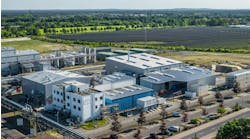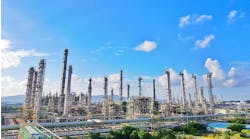SCREW COMPRESSORS
Figure 2. Such units are unrivalled for small applications. Source: Accurate Air Engineering.
Few manufacturers produce large (say, above 0.8 MW) oil-free (dry-type) screw compressors. For some large sizes, only two or three oil-free screw compressor manufacturers can provide successful references. Other limiting factors in oil-free (dry-type) screw compressors are the discharge temperature and the differential pressure.In view of those limitations, plants often opt instead for oil-flooded screw compressors for medium and large applications (even for dry air ones such as instrument air or nitrogen packages). However, such compressors frequently suffer relatively high rate of wear and need complex sealing systems (whose seals are prone to abrasion and operational problems). Oil selection also presents a great challenge; highly sophisticated and expensive synthetic oil usually is necessary for successful operation.In oil-flooded screw compressors, air is mixed with a large quantity of oil; the oil then is extracted at discharge using very sophisticated multistage separation/filtration methods. Even the best oil-flooded screw compressor packages with the most effective and reliable oil separation systems still pass a certain level of oil. This amount of oil in a volume of compressed air may seem insignificant but for a compressor generating large air flow it can add up very quickly. The oil can build up in actuators (and other systems) and lead to sluggish and interrupted response. On the other hand, malfunction of a component in the complex oil-separation system can cause contamination of the air system with a huge amount of oil, which could result in extensive damage and potential for highly dangerous catastrophic failures (explosions, serious injuries to personnel, etc.). Vendors of oil-flooded screw compressors often offer "oil carryover" guarantees. However, they usually don't cover "oil carryover at any upset condition" and "oil carryover over the service life."Oil-free turbocompressors generally are the best options for dry air services, e.g., for instrument air, dry process air, etc. They have fewer wear parts than screw compressors and many use advanced oil-free bearings, so their reliability is better. Turbocompressors generally are lighter and smaller than comparable screw compressors. The most common turbocompressor designs have two or three centrifugal stages for pressure in the 7–12 Barg range. Centrifugal turbocompressors with eight-to-ten stages (usually in a form of integrally geared machines) can reach pressures up to 100 Barg (or even more). Units meeting the standards of the American Petroleum Institute (API), such as API 672 for integrally geared centrifugal turbocompressors, have been used for decades in critical air services. Complying with the standards' engineering, design, manufacturing, inspection and test requirements probably raises the cost of these highly engineered turbocompressors to two-to-four times that of conventional packages. However, they usually can provide three-to-five years' operation without any shutdown. Figure 3 shows an integrally geared API centrifugal compressor in a compact and well-arranged package. For general-purpose air services, a standard turbocompressor (with several successful operating references) from a reputable manufacturer usually is a good choice. Leading-edge designs using direct drive (i.e., no gear box), which have only one moving part spinning at high speeds, may be the best option for many applications.Relatively large applications (say, above 400 kW) call for use of oil-free magnetic bearings. For medium-size turbocompressors, simple and robust water-lubricated bearings or air-foil bearings suffice. Small-size units can get by with permanently lubricated and sealed bearings in special applications.Turbocompressors lend themselves to modularization, which can reduce the number of components and consequently cut both capital and operating expenses. A modular design may require change of some turbocompressor parameters (usually minor and module-specific adjustments) for each application. Figure 4 shows modern air-compressor-package modules in a plant.A fully integrated design with a turbocompressor using a direct-drive high-speed driver, a vertical air tank and an integral refrigerated dryer (probably with filters) can be supplied in a compact one-piece package.







